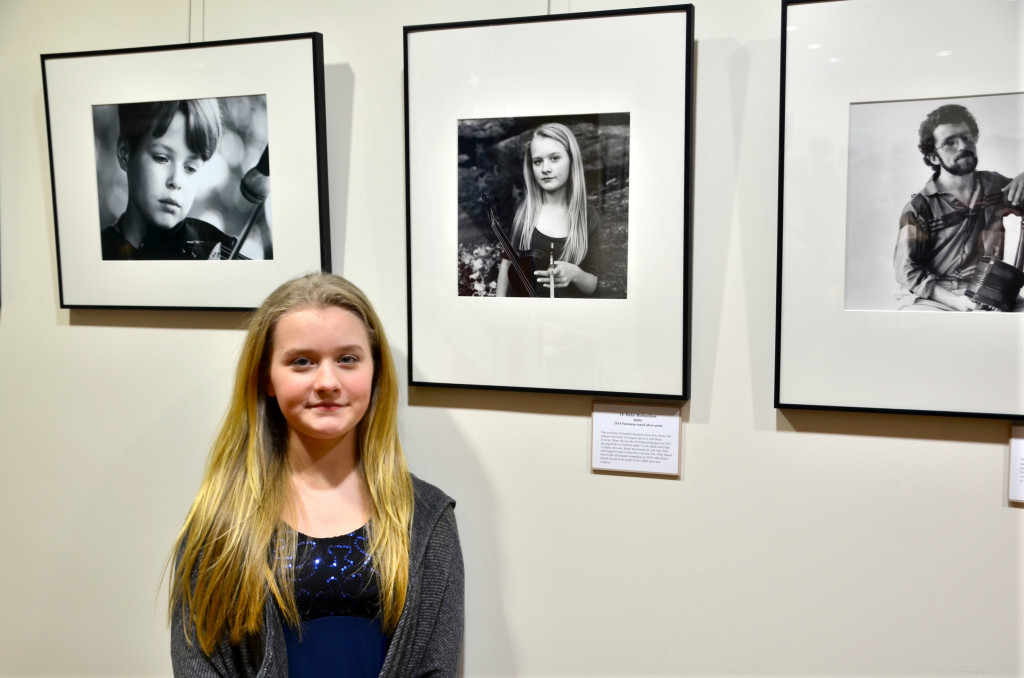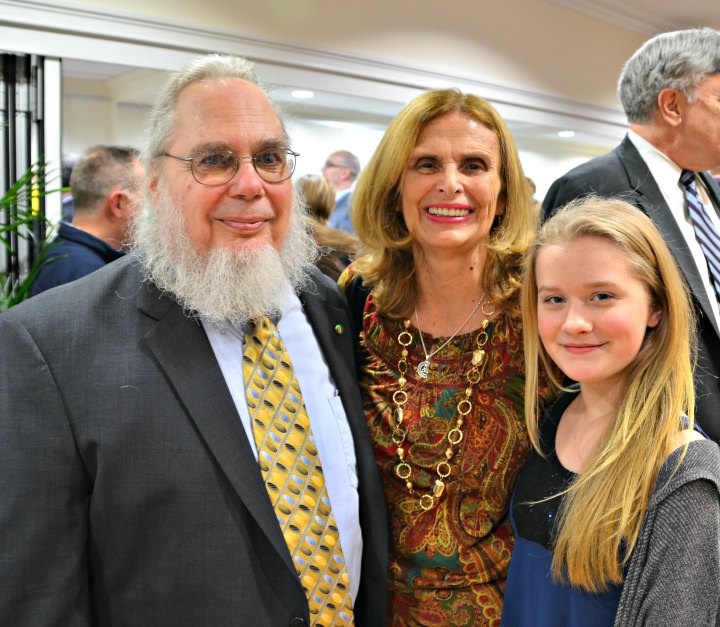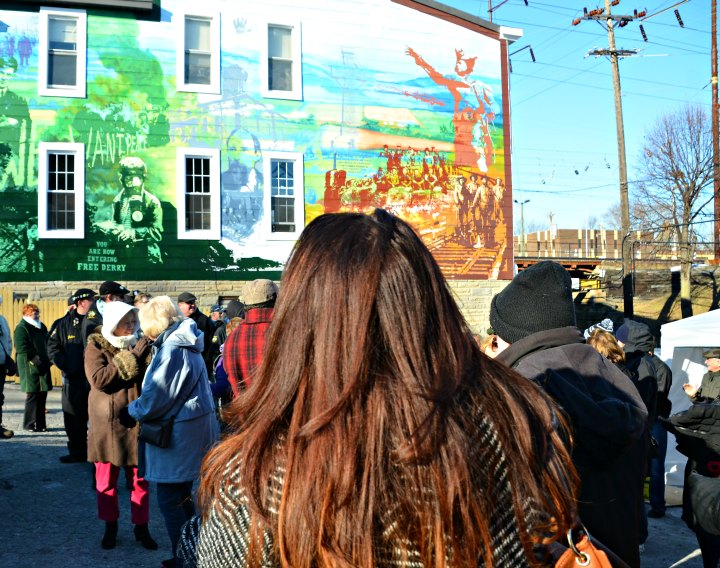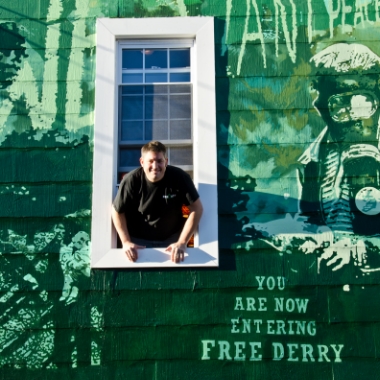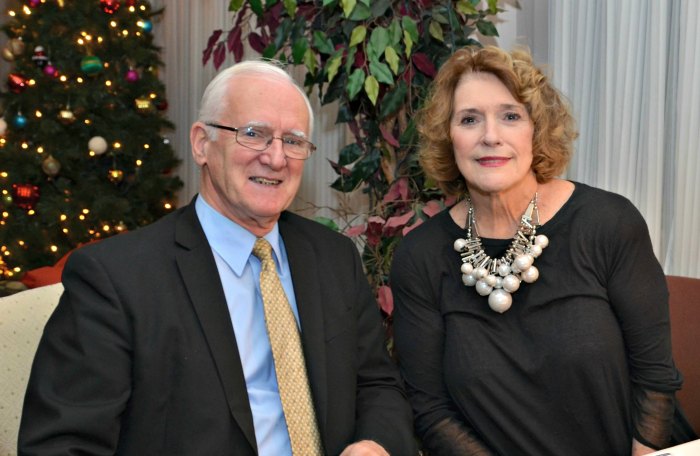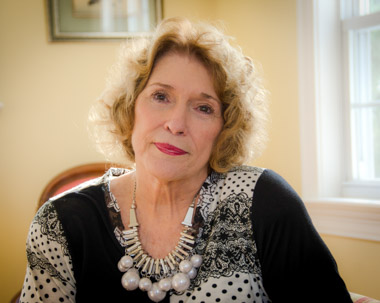
Kathy McGee Burns
“I’m bored with my story,” Kathy McGee Burns tells me as she settles down on a chair in front of her fireplace, where a gas fire leaps and dances. “You’re probably bored with my story too,” she laughs. She’s wearing a black and white dress with a commanding statement necklace of silver and pearlized globes the size of ping pong balls around her neck. “Like it?” she asks. “I was wearing it the other night at a meeting when I was introduced as ‘the shy’ Kathy McGee Burns. And I stood up and said, ‘Yes, I’m shy.’” She laughs again.
“Shy” is last adjective anyone would ever use to describe Kathy McGee Burns. And boring? Never. But over the past few years, as she racked up honor after honor—president of the Donegal Association, president of the Irish Memorial, president of the St. Patrick’s Day Observance Association, president of the Delaware Valley Irish Hall of Fame, board member of the Duffy’s Cut Project, the Claddagh Fund, and St. Malachy’s School—she’s had to tell her story again and again to reporters, including me. And now, as the Grand Marshal of the Philadelphia St. Patrick’s Day Parade—only the fourth woman since 1952 to receive that honor—Kathy McGee Burns has other things on her mind.
She suspects she was chosen GM this year because she is the mother of nine children and the theme of the parade is “St. Patrick, Bless, Strengthen and Pray for our Families,” appropriate for the year when Pope Francis will visit the city for the 2015 World Meeting of Families, a Catholic Church event held every three years. “I love and I’m proud of all my children, but I don’t want to just be known as the mother of nine children,” says the 78-year-old, who is a fulltime realtor.
For Kathy, “family” means more than the children she raised—for a few years supporting seven of them as a single mother on $100 a week—in the little house in Lafayette Hill where she’s lived for decades. But some of the story deserves a recap: She was a teen bride who had six children under the age of four—including a set of twins–by the time she was 20, and went on to have three more, the last two with her second husband, Mike Burns.
And despite her early start at motherhood. Kathy McGee Burns has nevertheless earned a berth in the Late Bloomers Hall of Fame—where, if past performance is predictive, she’ll wind up as its president. She enrolled in college when she was pregnant with her eighth child. It took her 16 years to graduate—she has a bachelor’s degree in history from Chestnut Hill College – and she attended Temple University Law School.
She also came late to her Irish heritage, though once she found it, it led her to a much deeper understanding of what “family” means.
Like many Irish Americans of a certain era, her father, Timothy Francis Aloysius McGee, a wholesale florist born in Philadelphia’s Swampoodle neighborhood, spoke little about his ancestry, though he unconsciously carried it on.
“I was baptized Mary Kathleen,” says Kathy. “I would always get teased. ‘Do you think you’re Irish?’ We were the only Irish family living in Flourtown, which is where my father settled. Like a lot of Irish people, he always wanted something better for his family. But in those days it really wasn’t popular to be Irish. I just wanted to be Kathy with an ‘i,’ which is what I was until I changed it to ‘y.’ “
Her father, she says, “always saw potential in me, always made me think I could do anything and be anything,” and pushed her to want more for herself. “I wanted to go to Springfield High School but he gave me two choices: I could go to Little Flower, which was two buses and a trolley, or I could go to Mount St. Joseph, which was within walking distance.”
She chose the Mount where she was, by her own account, “a controversial student.
“I questioned a lot of things,” she explains. “I was always rebelling against wearing the uniform. I always had a rip in it somewhere so I could wear street clothes–until Mother Superior caught on. I was asked to leave several times, but my father supplied all the flowers to the St. Joseph’s nuns, so. . . .” She grins.
She was 50 before she learned that her father’s family came from Donegal.
On his deathbed, her father gave her the only clue he had to their heritage. “He said, ‘Kath, you want to know where you’re from? We’re related to every McGee in Bridgeport.’” So she wrote to every McGee in Bridgeport, a little river town across from Norristown, until she found a woman, likely a cousin, who gave her an even slimmer clue: a song she’d heard her parents sing, “We come from Donegal where they eat potatoes skin and all.” “That’s all I needed, I joined the Donegal Society,” Kathy laughs.
And other organizations followed. She not only joined, but said yes to every task that was offered and ultimately came to head most of them. And with each one, she fell deeper in love with her heritage and more determined to find out where her McGees had come from. “When I walked into the Irish Center for the first time, I felt like I had come home,” she says. “The more I learned, the more I felt my family around me. I still think they’re around me all the time, pushing me in the right direction.”
It was her family, she says, that drew her to St. Malachy’s School in North Philadelphia, the celebrated K-8 parochial school whose graduates—most of them non-Catholics from the impoverished city neighborhood just off Broad Street—go on to higher education in larger numbers that most other city schools. She now sits on their board and helps raise money to keep this independent mission school, glowing as “a beacon of hope,” as it’s often called.
“St. Malachy’s is the parish where my grandmother, Mary Josephine Callahan, was born, baptized, confirmed and married. Her parents were Timothy Callahan and Bridget Clancy and she went to St. Malachy’s with her six sisters. She married Hughie McGee, my grandfather. I never met her, but I knew I got involved there because she made me.”
Likewise, when she was chosen to be Grand Marshal of the Donegal Association’s 125th Ball a year ago, her penchant for history led her to discover a family connection with the organization. “You know the money collected by the Ball is used for charity the whole year so I wondered what they’d raised money for that first year,” she says. “After that first ball, they donated money to a Father James McFadden, the parish priest in Gweedore.”
By this time, Kathy had traced her family back to this coastal town near the Bloody Foreland that was devastated during the Great Hunger, largely because they had been turned out of their homes for nonpayment of rent. Landlords had set rents at gouging prices largely, say historical records, to evict the Irish farmers from lands that could be more profitably used for livestock grazing by English and Scottish landlords. Father McFadden was a priest in the mold of the activist priests of the 1960s: Outspoken, he was the head of the National Land League which sought to reduce the outrageous rents levied by the largely absentee landlords in England and organized a boycott which resulted in his imprisonment for six months.
In February 1889, he was just finishing up Mass at St. Mary’s Church when a detective inspector came to the church to arrest him for encouraging parishioners to resist evictions. “One of my ancestors, Conal McGee, went to prison for his part in defending Father McFadden as they tried to pull him off the altar,” says Kathy. “That made being Grand Marshal of the Ball so meaningful to me. I believe,” she says, “that the spirits of our ancestors call us to them.”
It’s why she thinks she became so emotionally entangled with the story of Duffy’s Cut, the deaths of 57 Irish immigrants working on the Pennsylvania Railroad in Malvern in 1832. She shows me two small rusty nails she keeps in a bowl in her sitting room. They came from the coffin of John Ruddy, the 18-year-old Donegal immigrant who was one of the 57 victims, scholars now believe, of both cholera and religious intolerance that led to murder. Ruddy’s was the only body that was able to be identified because of his age, ship records, and a dental anomaly found in a Ruddy family from Inishowen in County Donegal.
Kathy helped pay for John Ruddy’s remains to be shipped to Donegal to be buried in his home soil and visited his grave in Ardara when she was in Donegal two years ago. Dr. William Watson, the Immaculata professor who helped locate the Duffy’s Cut remains and keep their memory alive, gave her the nails in thanks for her help in returning John Ruddy home.
“I just know that one of those people is related to me,” she says with conviction. “How else would I have been so drawn to them. Bill Watson talks about how he and his brother [Frank] were drawn to the story and so dedicated to finding them. I was drawn too.”
And family was on her mind in 2011 when, in her first year as president of the St. Patrick’s Day Parade committee, she stood at the lectern at St. Patrick’s Church Philadelphia during the pre-parade Mass and looked out at the audience. There, in the first few rows, were her children, grandchildren and siblings, but also her Donegal family, the McGees of Gweedore, found at last and confirmed through DNA testing. They included patriarch Hugh McGee, to whom she introduced her brother Hugh and his son, Hugh—all known as Hughie. There in spirit, her grandfather and her father’s brother, both Hughie (Her Gweedore cousin “looks just like my Uncle Hughie,” she says) and, of course, her father.
“While I was standing there, I found myself talking to my father. I know I’m going to cry as I say this.” Her hand goes to her eyes where the first tears are starting to well. “I said, ‘Dad, look at me. How did I get here?’ Whenever someone has a big accomplishment in our family, we all say the same thing: ‘I wish Pop-Pop was here to see this.’ I wish he had been there, though I think he was.”
And she expects him to be with her on Sunday, March 15, when she watches the St. Patrick’s Day Parade from the Grand Marshal’s seat overlooking the performing area near Eakins Oval on the Parkway. “This honor, this is the biggest thing that has ever happened to me,” she says. “I know he would be proud of me.”
* * * * * * * * * * * * * * * * * * * * * * * * * * * * *
A Message from Kathy McGee Burns’ Family in Ireland
The news that our own Kathy Mc Gee Burns has been selected as Grand Marshal for the Saint Patrick’s day parade in Philadelphia for 2015 has been received with great excitement and pride by her extended family in Donegal. Kathy has been doing Trojan work since 1986 for the Irish diaspora in Philadelphia. Her relations from Donegal are very excited about Kathy’s achievement. The McGee family from Carrick, Gweedore believe that her selection as Grand Marshal is a very historic moment for the extended family. They wish Kathy and her family all the best and the Mc Gees from Gweedore hope to be part of the parade on this very special day.
What Others Have to Say About Kathy McGee Burns
The Philadelphia St. Patrick’s Day Observance Association received dozens of letters nominating Kathy McGee Burns as the parade Grand Marshal. Here are excerpt from a few:
“At the Mount we believe we are in the business of training our young women to be leaders. Kathy is a fine example of our mission which states, ‘On the education of women largely depends the future of society.’ Throughout her personal and professional career, Kathy has demonstrated faithfulness to the Irish community that is to be admired.”
Sister Kathleen Brabson, SSJ
President
Mount Saint Joseph Academy
“I have had the privilege of working with Kathy on several boards and have always been inspired by her unwavering commitment to success for every organization she chooses to serve. Her enthusiasm and her love for all things Irish in the Philadelphia community are truly second to none.”
Bill Donohue
President
Sons and Daughters of Derry
“There is an old adage that says: If you want something done, ask a busy woman or man. I don’t know how Kathy has managed all that she has done while at the same time raising a large family.”
[The late] Joseph E. Montgomery
AOH Div. 65
“. . .Everyone who knows Kathy feels the same way about her—that her love and commitment to the Irish community as a leader, a friend, and a mentor is simply amazing.”
Kathleen Sullivan
President
Irish Memorial Board
“Kathy is a good friend and willing mentor, generous with her time, experience, and advice. Her support was invaluable as I was trying to find my feet in our community and I am deeply grateful for her continued support of my work at the Immigration Center. Kathy is a strong role model for women in our community and has helped pave the way for many younger women to get involved. . . .[Kathy’s] enthusiasm for all things Irish is infectious and allows her to draw people from all walks of life into causes that she cares about, and the Parade is no exception.”
Siobhan Lyons
Executive Director
Irish Immigration Center of Greater Philadelphia
“One doesn’t achieve success in our business like Kathy McGee Burns without extraordinary dedication and passion. Kathy has such dedication, not only in her profession of helping people find the home of their dreams and her unwavering loyalty to our company over the years, but also an exceptional passion for her Irish heritage.”
Lawrence F. Flick IV
Chairman and Chief Executive Officer
Fox & Roach Realtors
Berkshire Hathaway
“I cannot imagine a more worthy selection for Grand Marshal. Her passion and dedication for both her Irish heritage and this parade have always been infectious among our family and friends. I’ve seen it firsthand, as two of my closest friends, who had no previous ties to the event whatsoever, became ardent parade followers and attendees after one conservation with “Grammy” about what it means to be Irish. That may be the most extreme example, but it is hardly the only one.
The commitment to her roots is only exceeded by the one to our large family, within which she has maintained matriarch status for as long as I can remember. To me, it truly isn’t a family function until she is there. Her ability to juggle all of these responsibilities is made possible by one simple thing. She has to be the youngest 78-year-old on Earth, which is just another reason she makes such a great ambassador for the parade and the Irish community of Philadelphia. “
Alexander Lee
Grandson

